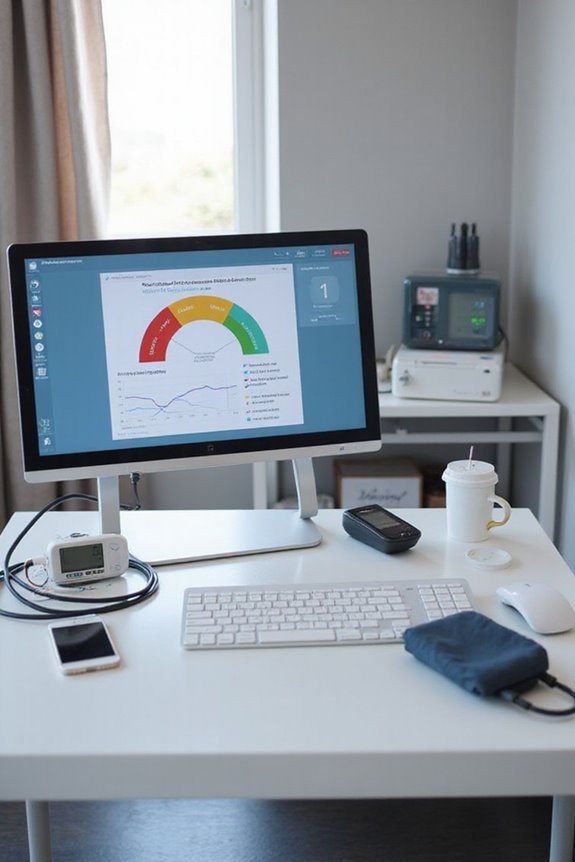Technology greatly reduces healthcare costs for pain patients through various methods. Telemedicine saves patients an average of $52 per appointment by eliminating travel costs. Remote monitoring leads to an 87% reduction in hospitalizations and a 35% decrease in overall healthcare costs. AI solutions enhance predictive analytics, optimizing treatment strategies and improving resource efficiency. Finally, electronic health records improve billing accuracy, resulting in estimated savings of $86,400 per provider over five years. Continued exploration reveals more insights.
Key Takeaways
- Telemedicine eliminates travel costs, saving patients an average of $52 per appointment and reducing overall healthcare expenses.
- Predictive analytics and AI optimize treatment plans, minimizing unnecessary procedures and lowering hospital visit rates.
- Electronic Health Records (EHR) improve billing accuracy, leading to an estimated savings of $86,400 per provider over five years.
- Wearable technology encourages patient engagement and continuous monitoring, enabling timely adjustments that enhance treatment effectiveness and reduce costs.
- Innovative therapies like Virtual Reality and regenerative medicine offer long-term solutions, potentially decreasing reliance on costly pain management interventions.
The Role of Telemedicine in Pain Management
How has telemedicine transformed pain management for patients? Telehealth has introduced significant benefits, reshaping the way pain management is approached.
- Cost Efficiency: Patients save an average of $52 per appointment by bypassing travel and indirect expenses, reducing overall healthcare costs.
- Accessibility: Telemedicine connects patients in remote areas with specialists, breaking down geographic barriers.
- Convenience: Flexible scheduling enables patients with varying mobility and symptom severity to maintain consistent care.
- Stigma Reduction: Virtual consultations alleviate anxiety for patients with coexisting conditions, fostering a more comfortable care environment.
- Continuity of Care: Enhanced access allows for timely follow-ups and treatment adjustments, improving patient outcomes.
Enhancing Patient Care With Remote Monitoring

Remote monitoring has emerged as a pivotal advancement in enhancing patient care, particularly for those managing chronic pain. This technology offers significant remote monitoring benefits, including decreased hospital admissions and improved disease management.
Key statistics include:
- 87% reduction in hospitalizations.
- 76% reduction in readmission risk.
- 35% decrease in overall healthcare costs through early interventions.
Patient engagement strategies are integral to the effectiveness of remote monitoring. By fostering continuous communication and monitoring, healthcare providers can optimize treatment plans, ensuring timely interventions that enhance patient outcomes.
Moreover, remote monitoring facilitates fewer in-person visits, reducing overall costs for patients. This approach supports whole-person care, improving both health outcomes and patient satisfaction. Ultimately, remote monitoring represents a transformative effort in chronic pain management.
AI Solutions for Efficient Pain Treatment

AI technologies are transforming pain treatment by enhancing efficiency and precision in clinical settings.
- AI Advancements: Predictive analytics utilize clinical data to forecast patient-specific pain outcomes, enabling targeted therapies. Machine learning algorithms can identify distinct pain profiles, optimizing treatment strategies.
- Treatment Optimization: AI analyzes multimodal data, such as clinical notes and imaging, to customize pain management plans. This approach reduces trial-and-error prescribing, leading to safer, cost-effective alternatives to opioids.
- Continuous Monitoring: AI facilitates real-time adjustments to treatment interventions, improving overall efficacy.
- Resource Efficiency: By minimizing unnecessary procedures and hospital visits, AI-driven solutions enhance patient access and reduce healthcare costs associated with chronic pain management.
These AI solutions embody a significant leap toward efficient, personalized pain care.
Streamlining Processes With Electronic Health Records

The implementation of Electronic Health Records (EHRs) greatly enhances healthcare efficiency, particularly in managing pain treatment processes. EHR integration benefits include cost savings estimated at approximately $86,400 per provider over five years, primarily from decreased drug expenditures and improved billing accuracy.
- Automating routine paperwork reduces administrative overhead, while centralized patient data access improves clinical decisions.
- Enhanced coordination reduces duplicated tests, addressing data sharing challenges across providers.
Hospitals using basic EHRs reported an average cost reduction of 12%. However, advanced systems did not yield significant additional savings, indicating diminishing returns.
Empowering Patients Through Wearable Technology

Advancements in wearable technology have emerged as a complementary approach to the efficiencies gained from Electronic Health Records (EHRs), particularly in the management of pain.
- Wearable devices greatly increase physical activity in pain patients, enhancing mobility and overall health.
- Continuous monitoring and wearable feedback motivate adherence to exercise regimens, essential for managing chronic pain.
- Real-time symptom tracking allows for timely adjustments in pain management, potentially reducing emergency visits.
- Data transparency empowers patients to understand their pain patterns and engage in proactive self-care.
- Personalized care plans, driven by the data collected from wearables, can optimize treatment and reduce healthcare costs.
This integration of wearable technology fosters a sense of ownership in pain management, encouraging individuals to take control of their health.
Predictive Analytics in Managing Pain Conditions
Utilizing predictive analytics in managing pain conditions has become increasingly essential for healthcare providers aiming to enhance patient outcomes and reduce costs. Predictive modeling leverages patient data to identify those at high risk for chronic pain, allowing for early interventions.
Key benefits include:
- Early Identification: Flags patients for potential chronic pain, aiding in timely risk evaluation.
- Resource Prioritization: Focuses resources on patients who would benefit most from preventive measures.
- Surgical Decision-Making: Minimizes unnecessary surgeries by evaluating candidacy and risks of complications.
- Chronic Pain Management: Forecasts pain flares, enabling proactive care and personalized treatment plans.
Collectively, these strategies contribute to lower healthcare utilization and costs while improving patient satisfaction.
The Impact of Digital Tools on Administrative Efficiency
Digital tools greatly enhance administrative efficiency within healthcare systems. Approximately 25% of total U.S. healthcare spending, or roughly $1 trillion, is attributed to administrative tasks, underscoring the potential for cost savings through digitization.
Key improvements include:
- Automation of prior authorization and claims processing, which reduces manual labor and errors while speeding up administrative workflows.
- AI-driven coding optimization enhances billing accuracy, decreasing complexity and effort.
- Real-time location systems (RTLS) improve scheduling and reduce operational delays.
- Digital documentation streamlines quality reporting, lightening the load on clinicians and administrators.
Cost Savings Through Personalized Pain Management
How can personalized pain management strategies lead to significant cost savings in healthcare? Implementing personalized strategies in pain management can provide various cost-effective solutions, especially in oncology clinics. Key points include:
- Documenting patient-specific pain management goals (PPGs) can lower reported pain levels and treatment costs.
- Individualized pain targets are more efficient than unrealistic complete pain elimination.
- Multidisciplinary approaches enhance personalized goal setting.
- Educating patients on opioid use reduces complications and treatment expenses.
- Cognitive Behavioral Therapy (CBT) as a non-pharmacologic treatment can lower medication-related costs.
- Telemedicine facilitates remote consultations, reducing travel costs and emergency visits.
- Incorporating TENS units into pain management plans can offer drug-free relief options, further reducing reliance on medications.
These strategies collectively contribute to reduced healthcare utilization and foster a more engaged patient experience, ultimately leading to significant financial savings.
Future Trends in Technology for Pain Management
The landscape of pain management is evolving with the integration of advanced technologies, building on the cost-effective benefits of personalized pain management strategies.
Virtual Reality (VR) Therapy
- Immersive environments distract patients, reducing perceived pain intensity.
- Customizable programs cater to various pain conditions.
- Potential to decrease opioid reliance.
Artificial Intelligence (AI)
- Analyzes patient data to predict pain flare-ups.
- Supports personalized treatment protocols through machine learning.
Wearable Medical Technology
- Monitors physiological indicators for real-time feedback.
- Facilitates telehealth consultations, minimizing clinic visits.
Regenerative Medicine
- Explores stem cell therapies for tissue repair.
- Advances in gene editing may target genetic pain disorders.
These trends collectively indicate a shift towards more effective, personalized, and potentially cost-reducing pain management solutions.
Frequently Asked Questions
How Can Technology Improve Access to Pain Management Services?
Technology enhances access to pain management services through remote consultations and digital resources, bridging gaps for underserved populations. This approach fosters a sense of community, enabling individuals to engage in their care from the comfort of home.
What Are the Privacy Concerns With Using Digital Health Tools?
Privacy concerns surrounding digital health tools primarily focus on data security and the necessity of patient consent. Many patients fear unauthorized access to their health information, highlighting the need for enhanced protections and transparency in data handling practices.
Can Telehealth Replace In-Person Appointments Completely for Pain Patients?
Telehealth effectiveness indicates that while it enhances access and convenience, it cannot fully replace in-person appointments due to limitations in patient-provider dynamics and the need for physical assessments in managing complex pain conditions effectively.
How Do Wearable Devices Enhance Pain Management Strategies?
Wearable sensors enhance pain management strategies by enabling real-time pain tracking, which has shown to reduce healthcare costs by up to 30%. This technology promotes personalized treatment, fostering a sense of community among pain patients and caregivers.
What Are the Limitations of AI in Pain Management?
AI limitations in pain management stem from data accuracy issues, biased training datasets, and a lack of diverse representation. These factors hinder effective assessments, potentially exacerbating disparities and complicating the integration of AI into clinical practices.





